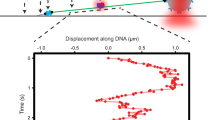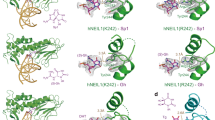Abstract
Nucleotide excision repair (NER) is a multistep process of recognition and elimination of a wide spectrum of damages that cause significant distortions in DNA structure, such as UV-induced damage and bulky chemical adducts. A series of model DNAs containing new bulky fluoro-azidobenzoyl photoactive lesion dCFAB and well-recognized nonnucleoside lesions nFlu and nAnt have been designed and their interaction with repair proteins investigated. We demonstrate that modified DNA duplexes dCFAB/dG (probe I), dCFAB/nFlu+4 (probe II), and dCFAB/nFlu−3 (probe III) have increased (as compared to unmodified DNA, umDNA) structure-dependent affinity for XPC—HR23B (Kd um > Kd I > Kd II ≈ Kd III ) and differentially crosslink to XPC and proteins of NER-competent extracts. The presence of dCFAB results in (i) decreased melting temperature (ΔTm = −3°C) and (ii) 12° DNA bending. The extended dCFAB/dG-DNA (137 bp) was demonstrated to be an effective NER substrate. Lack of correlation between the affinity to XPC—HR23B and substrate properties of the model DNA suggests a high impact of the verification stage on the overall NER process. In addition, DNAs containing closely positioned, well-recognized lesions in the complementary strands represent hardly repairable (dCFAB/nFlu+4, dCFAB/nFlu−3) or irreparable (nFlu/nFlu+4, nFlu/nFlu−3, nAnt/nFlu+4, nAnt/nFlu−3) structures. Our data provide evidence that the NER system of higher eukaryotes recognizes and eliminates damaged DNA fragments on a multi-criterion basis.
Similar content being viewed by others
Abbreviations
- dCFAB :
-
5-[3-(4-azido-2,3,5,6-tetrafluorobenzamido)propoxyprop-1-inyl]-2′-deoxycytidine
- dCFABG :
-
exo-N-[(4-azi-dotetrafluorobenzylidenehydrazinocarbonyl)butylcarbamoyl]-2′-deoxycytidine
- dCFAP :
-
exo-N-{2-[N-(4-azido-2,5-difluoro-3-chloropyridin-6-yl)-3-aminopropionyl]amino-ethyl}-2′-deoxycytidine
- dsDNA:
-
double-stranded DNA
- dUFAP :
-
5-{N-[N-(4-azido-2,5-difluoro-3-chloropyridin-6-yl)-3-aminopropionyl]-trans-3-aminopropenyl-1}-2′-deoxy-uridine
- Kd:
-
dissociation constant
- n:
-
nucleotide
- nAnt:
-
a nonnucleoside insert containing anthracenyl residue (N-[6-(9-anthracenyl-carbamoyl)hexanoyl]-3-amino-1,2-propanediol)
- NER:
-
nucleotide excision repair
- nFlu:
-
a nonnucleoside insert containing fluorescein residue (N-[6-(dipivaloyl-5(6)-fluoresceinyl-carbamoyl)hexanoyl]-O1-(4,4′-dimethoxytrityl)-O2-[(diisopropylamino)(2-cyanoethoxy)phosphino]-3-amino-1,2-propanediol)
- ODN:
-
oligo(deoxy)ribonucleotide
- RPA:
-
replication protein A
- TFIIH:
-
transcription factor II human
- Tm:
-
DNA duplex melting temperature
- T4 PNK:
-
T4 polynucleotide kinase
- umDNA:
-
unmodified DNA
- XPC and XPD:
-
xeroderma pigmentosum group C
References
Gillet, L. C., and Schaerer, O. D. (2006) Molecular mechanisms of mammalian global genome nucleotide excision repair, Chem. Rev., 106, 253–276.
Hanawalt, P. C., and Spivak, G. (2008) Transcription-coupled DNA repair: two decades of progress and surprises, Nat. Rev. Mol. Cell Biol., 9, 958–970.
Petruseva, I. O., Evdokimov, A. N., and Lavrik, O. I. (2014) Molecular mechanism of global genome nucleotide excision repair, Acta Naturae, 6, 23–34.
Evdokimov, A., Petruseva, I., and Lavrik, O. I. (2014) Model DNA for investigation of mechanism of nucleotide excision repair, Biopolym. Cell, 30, 167–183.
Min, J. H., and Pavletich, N. P. (2000) Recognition of DNA damage by the Rad4 nucleotide excision repair protein, Nature, 449, 570–575.
Sugasawa, K., Akagi, J., Nishi, R., Iwai, S., and Hanaoka, F. (2009) Two-step recognition of DNA damage for mammalian nucleotide excision repair: directional binding of the XPC complex and DNA strand scanning, Mol. Cell, 36, 642–653.
Chen, X., Velmurugu, Y., Zheng, G., Park, B., Shim, Y., Kim, Y., Liu, L., Van Houten, B., He, C., Ansari, A., and Min, J. H. (2015) Kinetic gating mechanism of DNA damage recognition by Rad4/XPC, Nat. Commun., 6, 1–10.
Egly, J.-M., and Coin, F. (2011) A history of TFIIH: two decades of molecular biology on a pivotal transcription/repair factor, DNA Repair, 10, 714–721.
Naegeli, H., and Sugasawa, K. (2011) The xeroderma pigmentosum pathway: decision tree analysis of DNA quality, DNA Repair, 10, 673–683.
Ziani, S., Nagy, Z., Alekseev, S., Soutoglou, E., Egly, J.-M., and Coin, F. (2014) Sequential and ordered assembly of a large DNA repair complex on undamaged chromatin, J. Cell Biol., 206, 589–598.
Huang, J., and Sancar, A. (1994) Substrate spectrum of human excinuclease: repair of abasic sites, methylated bases, mismatches, and bulky adducts, J. Biol. Chem., 269, 19034–19040.
Evdokimov, A., Petruseva, I., Tsidulko, A., Koroleva, L., Serpokrylova, I., Silnikov, V., and Lavrik, O. (2013) New synthetic substrates of mammalian nucleotide excision repair system, Nucleic Acids Res., 41, e123.
Rechkunova, N. I., and Lavrik, O. I. (2010) Nucleotide excision repair in higher eukaryotes: mechanism of primary damage recognition in global genome repair, Subcell. Biochem., 50, 251–277.
Maltseva, E. A., Rechkunova, N. I., Gillet, L. C., Petruseva, I. O., Scharer, O. D., and Lavrik, O. I. (2007) Crosslinking of the NER damage recognition proteins XPC-HR23B, XPA and RPA to photoreactive probes that mimic DNA damages, Biochim. Biophys. Acta, 1770, 781–789.
Evdokimov, A. N., Petruseva, I. O., Pestryakov, P. E., and Lavrik, O. I. (2011) Photoactivated DNA analogs of sub-strates of the nucleotide excision repair system and their interaction with proteins of NER-competent extract of HeLa cells. Synthesis and application of long model DNA, Biochemistry (Moscow), 76, 157–166.
Schaerer, O. D. (2003) Chemistry and biology of DNA repair, Angew. Chem. Int. Ed. Engl., 42, 2946–2974.
Sutherland, B. M., Bennett, P. V., Sidorkina, O., and Laval, J. (2000) Clustered DNA damages induced in isolated DNA and in human cells by low doses of ionizing radiation, Proc. Natl. Acad. Sci. USA, 97, 103–108.
Sugasawa, K. (2006) XPC–HR23B expression and purification, Methods Enzymol., 408, 171–188.
Smeaton, M. B., Miller, P. S., Ketner, G., Les, A., and Hanakahi, L. A. (2007) Small-scale extracts for the study of nucleotide excision repair and non-homologous end joining, Nucleic Acids Res., 35, e152.
Petruseva, I. O., Tikhanovich, I. S., Maltseva, E. A., Safronov, I. V., and Lavrik, O. I. (2009) Photoactivated DNA analogs of substrates of the nucleotide excision repair system and their interaction with proteins of NER-competent HeLa cell extract, Biochemistry (Moscow), 74, 491–501.
Lane, D., Prentki, P., and Chandler, M. (1992) Use of gel retardation to analyze protein–nucleic acid interactions, Microbiol. Rev., 56, 509–528.
Evdokimov, A. N. (2014) Design of Analogs of Substrates for the Nucleotide Excision Repair System and Analysis of Their Interaction with Cell Extract Proteins, PhD thesis, ICBFM SB Russian Academy of Sciences, Novosibirsk.
Ilina, E. S., Khodyreva, S. N., Berezhnoy, A. E., Larin, S. S., and Lavrik, O. I. (2010) Tracking Ku antigen levels in cell extracts with DNA containing abasic sites, Mutat. Res., 685, 90–96.
Oksenych, V., and Coin, F. (2010) The long unwinding road: XPB and XPD helicases in damaged DNA opening, Cell Cycle, 9, 90–96.
Fan, L. (2013) How two helicases work together within the TFIIH complex, a perspective from structural studies of XPB and XPD helicases, Front. Biol., 8, 363–368.
Guggenheim, E. R., Xu, D., Zhang, C. X., Chang, P. V., and Lippard, S. J. (2009) Photoaffinity isolation and identification of proteins in cancer cell extracts that bind to platinum-modified DANN, Chembiochem, 10, 141–157.
Krasikova, Y. S., Rechkunova, N. I., Maltseva, E. A., Pestryakov, P. E., Petruseva, I. O., Sugasawa, K., Chen, X., Min, J. H., and Lavrik, O. I. (2013) Comparative analysis of interaction of human and yeast DNA damage recognition complexes with damaged DNA in nucleotide excision repair, J. Biol. Chem., 288, 10936–10947.
Liu, Y., Reeves, D., Kropachev, K., Cai, Y., Ding, S., Kolbanovskiy, M., Kolbanovskiy, A., Bolton, J., Broyde, S., Van Houten, B., and Geacintov, N. E. (2011) Resistance of bulky DNA lesions to nucleotide excision repair can result from extensive aromatic lesion-base stacking interactions, DNA Repair, 10, 684–696.
Cosman, M., De los Santos, C., Fiala, R., Hingerty, B. E., Singh, S. B., Ibanez, V., Margulis, L. A., Live, D., Geacintov, N. E., and Broyde, S. (1992) Solution conformation of the major adduct between the carcinogen (+)-anti-benzo[a]pyrene diol epoxide and DNA, Proc. Natl. Acad. Sci. USA, 89, 1914–1918.
Wolski, S. C., Kuper, J., Hazelmann, P., Truglio, J. J., Croteau, D. L., Van Houten, B., and Kisker, C. (2008) Crystal structure of the FeS cluster-containing nucleotide excision repair helicase XPD, PLoS Biol., 6, e149.
Kuper, J., Wolski, S. C., Michels, G., and Kisker, C. (2012) Functional and structural studies of the nucleotide excision repair helicase XPD suggest a polarity for DNA translocation, EMBO J., 31, 494–502.
Mathieu, N., Kaczmarek, N., and Naegeli, H. (2010) Strand- and site-specific DNA lesion demarcation by the xeroderma pigmentosum group D helicase, Proc. Natl. Acad. Sci. USA, 107, 17545–17550.
Yeo, J. E., Khoo, A., Fagbemi, A. F., and Schaerer, O. D. (2013) The efficiency of damage recognition and excision correlate with duplex destabilization induced by acetylaminofluorene adducts in human nucleotide excision repair, Chem. Res. Toxicol., 25, 2462–2468.
Lee, Y., Cai, Y., Mu, H., Broyde, S., Amin, S., Chen, X., Min, J., and Geacintov, N. E. (2014) The relationships between XPC binding to conformationally diverse DNA adducts and their excision by the human NER system: is there a correlation? DNA Repair, 19, 55–63.
Colton, S. L., Xu, X. S., Wang, Y. A., and Wang, G. (2006) The involvement of ataxia-telangiectasia mutated protein activation in nucleotide excision repair, J. Biol. Chem., 281, 27117–27125.
Le May, N., Egly, J. M., and Coin, F. (2010) True lies: the double life of the nucleotide excision repair factors in tran-scription and DNA repair, J. Nucleic Acids, pii: 616342.
Kauffmann, A., Rosselli, F., Lazar, V., Winnepenninckx, V., Mansuet-Lupo, A., Dessen, P., Van den Oord, J. J., Spatz, A., and Sarasin, A. (2008) High expression of DNA repair pathways is associated with metastasis in melanoma patients, Oncogene, 27, 565–573.
Author information
Authors and Affiliations
Corresponding author
Additional information
Original Russian Text © N. V. Lukyanchikova, I. O. Petruseva, A. N. Evdokimov, V. N. Silnikov, O. I. Lavrik, 2016, published in Biokhimiya, 2016, Vol. 81, No. 3, pp. 386–400.
Rights and permissions
About this article
Cite this article
Lukyanchikova, N.V., Petruseva, I.O., Evdokimov, A.N. et al. DNA with damage in both strands as affinity probes and nucleotide excision repair substrates. Biochemistry Moscow 81, 263–274 (2016). https://doi.org/10.1134/S0006297916030093
Received:
Revised:
Published:
Issue Date:
DOI: https://doi.org/10.1134/S0006297916030093




